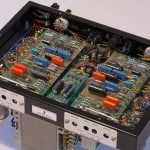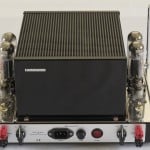
Hello Will. Anyone with an iota of knowledge of Radford’s place in audio history could not fail the understand your motivation re Radford Revival. However I guess that the behind the scenes discussions, assurances re being the custodian of the heritage and related matters required considerable patience. Would you care to tell us the ‘back-story’?
My father Steve was heavily involved in repairing and restoring vintage valve equipment throughout the 1970s & 1980s, especially Radford valve amplifiers. He knew John Widgery, a Radford employee who went on to form Sondex, which later became Woodside electronics. Steve was employed in the 1980s by John to build a batch of the STA25 Mark 4 Signature edition.
During the closure of Radford in 80s, Steve was given various Radford spares from the factory by John and Arthur Radford. Most importantly, he was given the original hand drafted drawings for the Series 3 metalwork. Throughout the 1990s and early 2000s these were untouched as he was running a computer graphics and design company. In early 2011 we initially had the idea to use our blueprints to provide a spares service for those with broken or incomplete Radfords, but it soon dawned on us we had the resources to manufacture entire new amplifiers. With the acquisition of the original transformer specifications we soon had everything we needed.
Given the changes in component technology and the non-availability of some original parts, what were and remain the primary challenges in making say the STA25 re-issue sonically indistinguishable from it’s illustrious predecessor?
The most difficult and crucial part of the amplifiers to perfect are the output transformers. Luckily, perhaps miraculously, we were able to get hold of the original winding specifications for not only these, but for much of the other Radford and Woodside equipment that was made.
Passive component technology has improved and the amplifiers benefit from this. Not necessarily in sonic terms but due to modern tolerances and consistency between components. No exotic components are necessary, the basic design relied upon technically sound engineering to achieve a very performant amplifier. They measure well as well as being highly subjectively rated. I believe the impressive electrical performance of the Radfords has a lot to do with their good subjective reputation.
Can you tell us a little – or a lot if you wish – about the re-issue you are most proud of?
I am especially proud of how we were able to make them faithful to the originals to the point where the new parts are (mostly) interchangeable with old ones. This means we are able to offer a spares service for those with original Radfords. Some of the parts we can supply include handles, transformer cages, bottom plates, valve runners and PCBs.
Not only that, we have subtly and tastefully improved the casework in some areas. We use stainless steel instead of galvanised steel for the main transformer chassis, and bright annealed stainless steel for the valve runners which were originally also galvanised. This improves their appearance without being “blingy” and over the top, and also contributes to the longevity of the amplifiers.

Another enhancement we have made is the use of quality bushings embedded in the metalwork to do away with the dreaded spire clips that held the originals together. It’s a pleasure to screw the amplifiers together with such ease and accuracy.
The transformers are also of a particularly high quality. They are made to modern insulation and safety standards, and are also vacuum impregnated for long term protection against humidity. We also use terminating tags embedded in the bobbins, which is an improvement over the originals, which used tags glued to the outer insulation.
Okay. Now then, could you describe in one paragraph just why valve amplifiers sound better?
We don’t necessarily believe this as a blanket statement. We could quite easily claim they do but that would be dishonest of us. Valve amplifiers tend to have good subjective performance for various reasons, but I don’t believe it’s true that valve amplifiers sound better as a hard rule.
Is it correct to say that valves have a much greater overload capacity than transistors, essential as music is so transient?
Not quite - a valve amplifier can and will clip just like a transistor amplifier. They run out of voltage or current capability in a similar fashion. It is well known that valve amplifiers tend to have softer clipping behaviour than solid state amplifiers, but this is largely due to the lower amounts of negative feedback they use. Not all valve amplifiers clip softly. For example, the Radfords clip very much like transistor amplifiers, due to their relatively high amount of negative feedback. This is not a bad thing, it is just how high feedback circuits behave. They try to maintain linearity until they can no longer deliver any more voltage or current.
However, valves can (in general) handle thermal overload much more readily than solid state devices. A transistor might immediately fail in a situation of heavy overload whereas a valve’s anode may just glow red until the overload condition is removed.

In layman’s terms then – does this mean there is massive ‘headroom’ so the loud passages can be reproduced without distortion?
Valve amplifiers are subject to the exact headroom limitations as transistor amplifiers. To say otherwise would be misleading.
What are the current design and materials limitations that confront all intelligent skilled audio designers today?
There is a huge array of excellent passive and active components available nowadays, so I do not believe it is the materials and components that are the limiting factor in audio design, the exception perhaps being loudspeakers where advances in material science could bring about improvements.
What about creativity, innovation and other ‘motivators?
I think nowadays in audio there is a trend of innovation for the sake of it, which often ends up being of little benefit to the customer. Our amplifiers were designed in the early 1960s, yet we are told by our customers that our equipment has brought them more enjoyment than much more expensive “state of the art” products.
Do you have any particular priorities, other than the obvious one of sound quality, when you approach the design of re-issues?
Our main priority was to retain the authenticity of the amplifiers, and also to keep construction quality extremely high.
To what extent – if any – does marketing influence your designs?
In addition to offering a replica of the original Series 3, we also offer a slightly updated version that we call the Series 5, to cater to a more modern market. The Series 5 adds an IEC mains inlet instead of a captive power lead. We also did away with the mains voltage selector and octal socket that was originally used to power the SC22 preamp. We offer the Series 5 in an attractive gloss black as well as the classic two tone grey, and for an extra charge any other colour the customer may desire.
We weren’t 100% certain of the market but we believed we would to be able to sell a modest number to Radford fans and enthusiast who want a chance to own an iconic amplifier. Profit was not the prime motivator. Our amps aren’t just aimed at Radford enthusiasts - they stand on their own as a very fine product. Eventually we hope to release some exciting new equipment such as a preamplifier that is a good visual and sonic match for the Radfords, but also stand on their own as excellent, like the power amps.
To what extent does marketing into your home market differ from marketing to your foreign distributors?
Our marketing is solely web based at this time so it is directed at a worldwide audience. We sell direct and currently have no distributors.
I’m curious about the gestation process you go through designing a re-issue. How do you normally operate from, say, a clean sheet of paper?
In some ways it’s more difficult than starting from a clean sheet - you have to spend a lot of time making sure modern equivalents to the original components actually fit in the same spaces. In the end we managed to do this with minimum compromise.
What are your feelings about the whole digital / analog controversy?
In my mind there isn’t really a controversy, most people these days seem to accept both. With the revived interest in vinyl, people who previously had a purely digital music collection are now experimenting with analog, and a lot of vinyl-only people are beginning to be lured by the convenience of modern hard-drive based music servers and players.
Thank you Will.
Thank you Howard.






